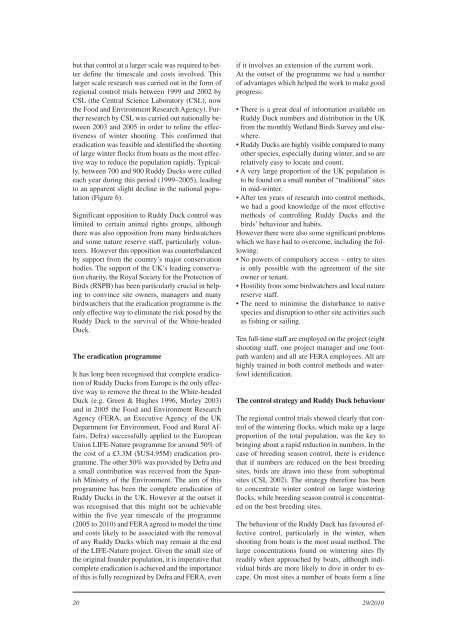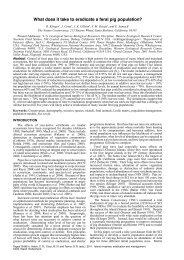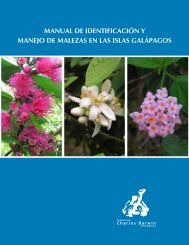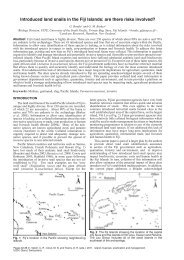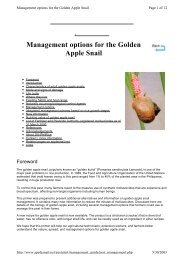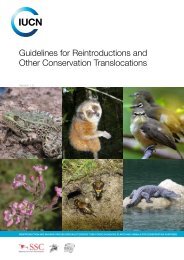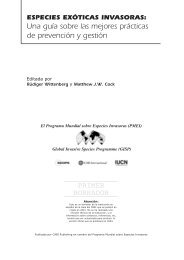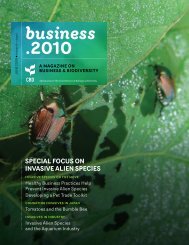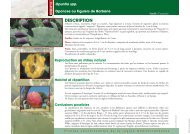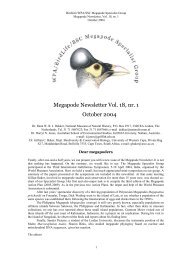Aliens Newsletter - ISSG
Aliens Newsletter - ISSG
Aliens Newsletter - ISSG
You also want an ePaper? Increase the reach of your titles
YUMPU automatically turns print PDFs into web optimized ePapers that Google loves.
ut that control at a larger scale was required to better<br />
define the timescale and costs involved. This<br />
larger scale research was carried out in the form of<br />
regional control trials between 1999 and 2002 by<br />
CSL (the Central Science Laboratory (CSL), now<br />
the Food and Environment Research Agency). Further<br />
research by CSL was carried out nationally between<br />
2003 and 2005 in order to refine the effectiveness<br />
of winter shooting. This confirmed that<br />
eradication was feasible and identified the shooting<br />
of large winter flocks from boats as the most effective<br />
way to reduce the population rapidly. Typically,<br />
between 700 and 900 Ruddy Ducks were culled<br />
each year during this period (1999–2005), leading<br />
to an apparent slight decline in the national population<br />
(Figure 6).<br />
Significant opposition to Ruddy Duck control was<br />
limited to certain animal rights groups, although<br />
there was also opposition from many birdwatchers<br />
and some nature reserve staff, particularly volunteers.<br />
However this opposition was counterbalanced<br />
by support from the country’s major conservation<br />
bodies. The support of the UK’s leading conservation<br />
charity, the Royal Society for the Protection of<br />
Birds (RSPB) has been particularly crucial in helping<br />
to convince site owners, managers and many<br />
birdwatchers that the eradication programme is the<br />
only effective way to eliminate the risk posed by the<br />
Ruddy Duck to the survival of the White-headed<br />
Duck.<br />
The eradication programme<br />
It has long been recognised that complete eradication<br />
of Ruddy Ducks from Europe is the only effective<br />
way to remove the threat to the White-headed<br />
Duck (e.g. Green & Hughes 1996, Morley 2003)<br />
and in 2005 the Food and Environment Research<br />
Agency (FERA, an Executive Agency of the UK<br />
Department for Environment, Food and Rural Affairs,<br />
Defra) successfully applied to the European<br />
Union LIFE-Nature programme for around 50% of<br />
the cost of a £3.3M ($US4.95M) eradication programme.<br />
The other 50% was provided by Defra and<br />
a small contribution was received from the Spanish<br />
Ministry of the Environment. The aim of this<br />
programme has been the complete eradication of<br />
Ruddy Ducks in the UK. However at the outset it<br />
was recognised that this might not be achievable<br />
within the five year timescale of the programme<br />
(2005 to 2010) and FERA agreed to model the time<br />
and costs likely to be associated with the removal<br />
of any Ruddy Ducks which may remain at the end<br />
of the LIFE-Nature project. Given the small size of<br />
the original founder population, it is imperative that<br />
complete eradication is achieved and the importance<br />
of this is fully recognized by Defra and FERA, even<br />
if it involves an extension of the current work.<br />
At the outset of the programme we had a number<br />
of advantages which helped the work to make good<br />
progress:<br />
• There is a great deal of information available on<br />
Ruddy Duck numbers and distribution in the UK<br />
from the monthly Wetland Birds Survey and elsewhere.<br />
• Ruddy Ducks are highly visible compared to many<br />
other species, especially during winter, and so are<br />
relatively easy to locate and count.<br />
• A very large proportion of the UK population is<br />
to be found on a small number of “traditional” sites<br />
in mid-winter.<br />
• After ten years of research into control methods,<br />
we had a good knowledge of the most effective<br />
methods of controlling Ruddy Ducks and the<br />
birds’ behaviour and habits.<br />
However there were also some significant problems<br />
which we have had to overcome, including the following:<br />
• No powers of compulsory access – entry to sites<br />
is only possible with the agreement of the site<br />
owner or tenant.<br />
• Hostility from some birdwatchers and local nature<br />
reserve staff.<br />
• The need to minimise the disturbance to native<br />
species and disruption to other site activities such<br />
as fishing or sailing.<br />
Ten full-time staff are employed on the project (eight<br />
shooting staff, one project manager and one footpath<br />
warden) and all are FERA employees. All are<br />
highly trained in both control methods and waterfowl<br />
identification.<br />
The control strategy and Ruddy Duck behaviour<br />
The regional control trials showed clearly that control<br />
of the wintering flocks, which make up a large<br />
proportion of the total population, was the key to<br />
bringing about a rapid reduction in numbers. In the<br />
case of breeding season control, there is evidence<br />
that if numbers are reduced on the best breeding<br />
sites, birds are drawn into these from suboptimal<br />
sites (CSL 2002). The strategy therefore has been<br />
to concentrate winter control on large wintering<br />
flocks, while breeding season control is concentrated<br />
on the best breeding sites.<br />
The behaviour of the Ruddy Duck has favoured effective<br />
control, particularly in the winter, when<br />
shooting from boats is the most usual method. The<br />
large concentrations found on wintering sites fly<br />
readily when approached by boats, although individual<br />
birds are more likely to dive in order to escape.<br />
On most sites a number of boats form a line<br />
20 29/2010


